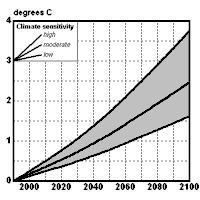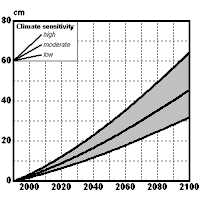 Introduction
Introduction Introduction
IntroductionWhile the scientific evidence is convincing, there are many uncertainties in understanding of the problem of global warming.
The fact that there is broad agreement between the model forecasts and observed trends in global temperature provides strong support for the greenhouse theory, but it is not conclusive proof.
There are other possible explanations for the warming trend: natural mechanisms of climatic change such as a change in the degree of volcanic or solar activity or in the distribution of ocean temperatures.
The temperature rise must continue for some years, surpassing the natural variability in climate, before other explanations can be wholly discounted and enhancement of the greenhouse effect firmly established as the cause. This is why the scientific community has yet to state with certainty that the greenhouse effect is responsible for the observed change in climate.


The range of projections of the future change in global-mean surface air
temperature and sea level. The central line indicates the most likely estimate
and the shaded area shows the range of possibilities. Based on the 1992
IPCC assessment.
Turning to the future, the projections of climate change for the 21st century are uncertain because of limited understanding of the manner in which the climate of the Earth will respond to the change in the composition of the atmosphere.
Furthermore, determining the ultimate impact of global warming on humanity is not an easy matter.
Forecasts are necessarily speculative. They rest on uncertain projections of changes in regional climate, highly simplified computer models of basic physical, biological and social processes, experience of past impacts and conjecture.
Given the uncertainties, is the evidence sufficient to justify immediate action to combat global warming?
According to the Ministerial Declaration of the Second World Climate Conference, held in 1990: "In order to achieve sustainable development in all countries and to meet the needs of present and future generations, precautionary measures to meet the climate challenge must anticipate, prevent, attack, or minimise the causes of, and mitigate the adverse consequences of, environmental degradation that might result from climate change. Where there are threats of serious or irreversible damage, lack of full scientific certainty should not be used as a reason for postponing cost-effective measures to prevent such degradation.
The international community has advised that, at this time, precautionary action should be taken in response to global warming.
Precautionary measures are those which would reduce the threat of global warming but are low in cost or else have significant benefits in other areas (for example, by reducing other pressing social, economic or environmental problems).
The reasons for this recommendation are twofold:
There are, in fact, many low-cost measures which could be taken now which would reduce the future threat of global warming and, at the same time, have immediate benefits in the present-day.
These cost-effective, precautionary measures would provide the basis for further action if advances in scientific understanding suggested they were needed and, as they also address current problems, they would be of advantage even if global warming proved not as substantial as feared.
 "Impact on Vietnam: Recent changes in climate and sea level"
"Impact on Vietnam: Recent changes in climate and sea level" Index
Index